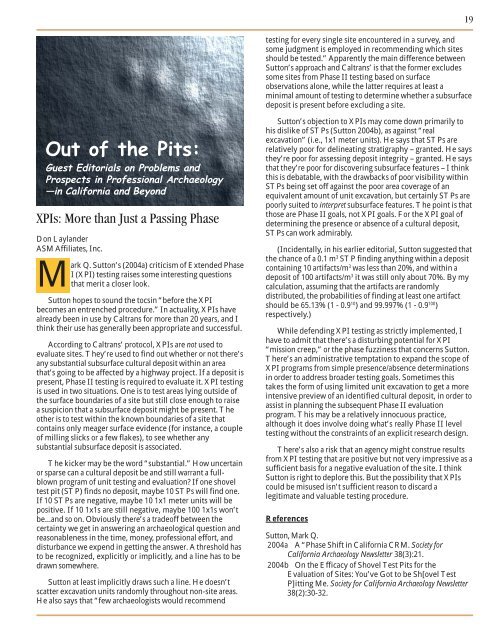Mammoth Rub Update - Society for California Archaeology
Mammoth Rub Update - Society for California Archaeology
Mammoth Rub Update - Society for California Archaeology
Create successful ePaper yourself
Turn your PDF publications into a flip-book with our unique Google optimized e-Paper software.
Out of the Pits:<br />
Guest Editorials on Problems and<br />
Prospects in Professional <strong>Archaeology</strong><br />
—in Cali<strong>for</strong>nia and Beyond<br />
XPIs: More than Just a Passing Phase<br />
Don Laylander<br />
ASM Affiliates, Inc.<br />
Mark Q. Sutton’s (2004a) criticism of Extended Phase<br />
I (XPI) testing raises some interesting questions<br />
that merit a closer look.<br />
Sutton hopes to sound the tocsin “be<strong>for</strong>e the XPI<br />
becomes an entrenched procedure.” In actuality, XPIs have<br />
already been in use by Caltrans <strong>for</strong> more than 20 years, and I<br />
think their use has generally been appropriate and successful.<br />
According to Caltrans’ protocol, XPIs are not used to<br />
evaluate sites. They’re used to find out whether or not there’s<br />
any substantial subsurface cultural deposit within an area<br />
that’s going to be affected by a highway project. If a deposit is<br />
present, Phase II testing is required to evaluate it. XPI testing<br />
is used in two situations. One is to test areas lying outside of<br />
the surface boundaries of a site but still close enough to raise<br />
a suspicion that a subsurface deposit might be present. The<br />
other is to test within the known boundaries of a site that<br />
contains only meager surface evidence (<strong>for</strong> instance, a couple<br />
of milling slicks or a few flakes), to see whether any<br />
substantial subsurface deposit is associated.<br />
The kicker may be the word “substantial.” How uncertain<br />
or sparse can a cultural deposit be and still warrant a fullblown<br />
program of unit testing and evaluation? If one shovel<br />
test pit (STP) finds no deposit, maybe 10 STPs will find one.<br />
If 10 STPs are negative, maybe 10 1x1 meter units will be<br />
positive. If 10 1x1s are still negative, maybe 100 1x1s won’t<br />
be...and so on. Obviously there’s a tradeoff between the<br />
certainty we get in answering an archaeological question and<br />
reasonableness in the time, money, professional ef<strong>for</strong>t, and<br />
disturbance we expend in getting the answer. A threshold has<br />
to be recognized, explicitly or implicitly, and a line has to be<br />
drawn somewhere.<br />
Sutton at least implicitly draws such a line. He doesn’t<br />
scatter excavation units randomly throughout non-site areas.<br />
He also says that “few archaeologists would recommend<br />
19<br />
testing <strong>for</strong> every single site encountered in a survey, and<br />
some judgment is employed in recommending which sites<br />
should be tested.” Apparently the main difference between<br />
Sutton’s approach and Caltrans’ is that the <strong>for</strong>mer excludes<br />
some sites from Phase II testing based on surface<br />
observations alone, while the latter requires at least a<br />
minimal amount of testing to determine whether a subsurface<br />
deposit is present be<strong>for</strong>e excluding a site.<br />
Sutton’s objection to XPIs may come down primarily to<br />
his dislike of STPs (Sutton 2004b), as against “real<br />
excavation” (i.e., 1x1 meter units). He says that STPs are<br />
relatively poor <strong>for</strong> delineating stratigraphy – granted. He says<br />
they’re poor <strong>for</strong> assessing deposit integrity – granted. He says<br />
that they’re poor <strong>for</strong> discovering subsurface features – I think<br />
this is debatable, with the drawbacks of poor visibility within<br />
STPs being set off against the poor area coverage of an<br />
equivalent amount of unit excavation, but certainly STPs are<br />
poorly suited to interpret subsurface features. The point is that<br />
those are Phase II goals, not XPI goals. For the XPI goal of<br />
determining the presence or absence of a cultural deposit,<br />
STPs can work admirably.<br />
(Incidentally, in his earlier editorial, Sutton suggested that<br />
the chance of a 0.1 m 3 STP finding anything within a deposit<br />
containing 10 artifacts/m 3 was less than 20%, and within a<br />
deposit of 100 artifacts/m 3 it was still only about 70%. By my<br />
calculation, assuming that the artifacts are randomly<br />
distributed, the probabilities of finding at least one artifact<br />
should be 65.13% (1 - 0.9 10 ) and 99.997% (1 - 0.9 100 )<br />
respectively.)<br />
While defending XPI testing as strictly implemented, I<br />
have to admit that there’s a disturbing potential <strong>for</strong> XPI<br />
“mission creep,” or the phase fuzziness that concerns Sutton.<br />
There’s an administrative temptation to expand the scope of<br />
XPI programs from simple presence/absence determinations<br />
in order to address broader testing goals. Sometimes this<br />
takes the <strong>for</strong>m of using limited unit excavation to get a more<br />
intensive preview of an identified cultural deposit, in order to<br />
assist in planning the subsequent Phase II evaluation<br />
program. This may be a relatively innocuous practice,<br />
although it does involve doing what’s really Phase II level<br />
testing without the constraints of an explicit research design.<br />
There’s also a risk that an agency might construe results<br />
from XPI testing that are positive but not very impressive as a<br />
sufficient basis <strong>for</strong> a negative evaluation of the site. I think<br />
Sutton is right to deplore this. But the possibility that XPIs<br />
could be misused isn’t sufficient reason to discard a<br />
legitimate and valuable testing procedure.<br />
References<br />
Sutton, Mark Q.<br />
2004a A “Phase Shift in Cali<strong>for</strong>nia CRM. <strong>Society</strong> <strong>for</strong><br />
Cali<strong>for</strong>nia <strong>Archaeology</strong> Newsletter 38(3):21.<br />
2004b On the Efficacy of Shovel Test Pits <strong>for</strong> the<br />
Evaluation of Sites: You’ve Got to be Sh[ovel Test<br />
P]itting Me. <strong>Society</strong> <strong>for</strong> Cali<strong>for</strong>nia <strong>Archaeology</strong> Newsletter<br />
38(2):30-32.

















